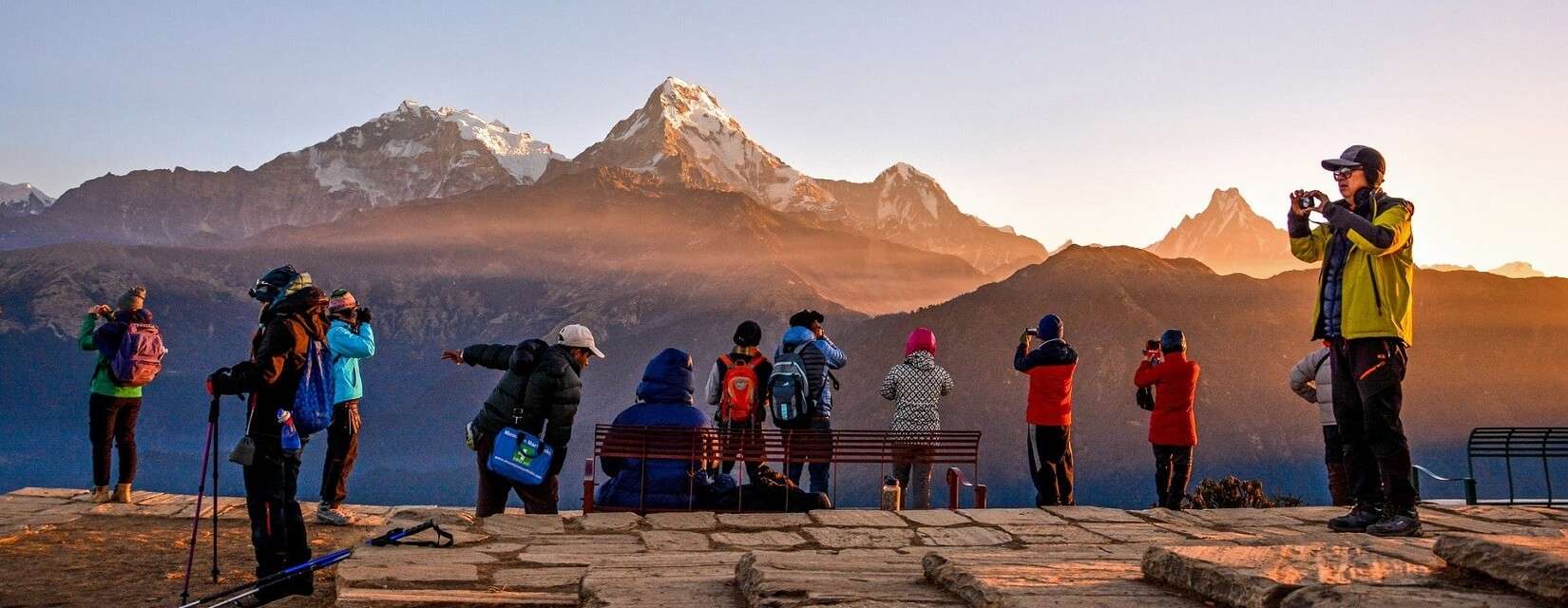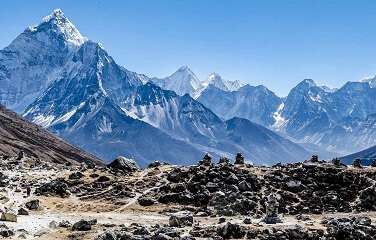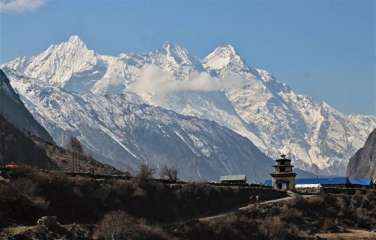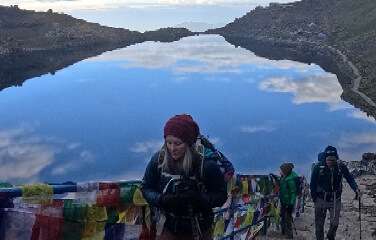Detailed Itinerary

Day 1: Pokhara to Nayapul and Trek to Tikhedhunga/Ulleri
- Distance: 10–12 km trek (4–5 hours).
- Altitude: Nayapul (1,070 m) to Tikhedhunga (1,540 m) or Ulleri (1,960 m).
- Highlights: A scenic drive from Pokhara to Nayapul, followed by a trek through terraced farmlands and lush forests. You’ll pass charming villages with views of the Annapurna mountains.
- Accommodation: Teahouses in Tikhedhunga or Ulleri.
Day 2: Tikhedhunga/Ulleri to Ghorepani
- Distance: 10 km trek (5–6 hours).
- Altitude: Ghorepani (2,850 m).
- Highlights: Begin with a steep climb up the stone steps to Ulleri, then pass through dense rhododendron forests with views of Annapurna South and Machapuchare. The day ends in Ghorepani, where trekkers rest before the early Poon Hill hike.
- Accommodation: Teahouses in Ghorepani.
Day 3: Poon Hill Sunrise Hike, Trek Back to Nayapul, and Return to Pokhara
- Distance: 5 km to Poon Hill round-trip, plus descent to Nayapul (8–9 hours).
- Altitude: Poon Hill viewpoint (3,210 m).
- Highlights: An early morning ascent to Poon Hill offers breathtaking sunrise views over the Annapurna and Dhaulagiri ranges, illuminating peaks like Annapurna I, Dhaulagiri, and Hiunchuli in hues of orange and pink. After returning to Ghorepani for breakfast, descend back to Nayapul, pass scenic waterfalls and villages, and drive back to Pokhara.
- Accommodation: Return to Pokhara.
Trek Highlights and Scenic Views

Mountain Views: Poon Hill offers views of the Annapurna, Dhaulagiri, and Nilgiri ranges.
Flora and Fauna: Rhododendron forests bloom in spring, and the trail is home to diverse bird species and occasional sightings of langur monkeys.
Cultural Immersion: Trekking through Gurung and Magar villages, trekkers experience local traditions, architecture, and cuisine.
Preparation and Packing Essentials
Clothing: Lightweight layers, waterproof jacket, warm layers for Poon Hill sunrise, and comfortable trekking shoes.
Trekking Gear: Trekking poles, a small backpack, and a headlamp for the early morning hike.
Documents: TIMS and ACAP permits (available in Pokhara or Kathmandu).
Fitness: Moderate fitness level recommended; pre-trek cardio or leg workouts can help.
Accommodation and Food
Teahouses: These are basic but comfortable accommodations with beds and shared bathrooms. Meals are simple but hearty, featuring Nepali staples like dal bhat and options like noodles and Tibetan bread.
Permits and Costs
Permits: Trekking permits include TIMS (Trekkers' Information Management System) and ACAP (Annapurna Conservation Area Permit).
Approximate Costs: $20–30 per day, covering meals, accommodation, and permits (excluding transportation).
Best Time to Trek

Autumn (September–November) and Spring (March-May) offer the best weather and clear views, while winter (December–February) brings colder temperatures and snow at higher altitudes. Monsoon season (June–August) is less popular due to rain and slippery trails.
Safety and Tips
Pace Yourself: Allow time for acclimatization, especially during uphill climbs.
Stay Hydrated: Bring a reusable water bottle; purification tablets are recommended.
Guide Requirement: In 2023, solo trekking regulations require a guide for safety, especially for first-time trekkers.
Responsible Trekking: Respect local customs and follow Leave No Trace principles to protect the environment.
Logistics and Accessibility
Starting Point: The trek begins in Nayapul, which is around a 1–2 hour drive from Pokhara. Pokhara, often reached via a scenic 6- to 7-hour drive or a quick 25-minute flight from Kathmandu, serves as the base.
Transportation: Shared or private jeeps are available from Pokhara to Nayapul. It’s also possible to arrange return transport in advance for convenience.
Guide and Porter: Hiring a guide is beneficial for understanding the local culture and navigating the trail, especially with updated regulations requiring guides for trekkers. Porters can be hired to carry heavier loads, which allows for a more enjoyable trek, especially on steep sections like the Ulleri steps.
Permits and Entry Points: TIMS and ACAP permits must be presented at entry checkpoints along the route. These can be arranged in either Kathmandu or Pokhara, and it’s best to carry multiple copies of your passport photo for permit applications and trail checkpoints.
Cultural Experiences and Etiquette

Village Life: Throughout the trek, you’ll encounter Gurung and Magar communities with traditional lifestyles that are rich in local customs. Many teahouses are family-owned, giving trekkers a chance to learn about regional traditions firsthand.
Traditional Cuisine: Local foods are a highlight of the experience, with the chance to enjoy dishes like dal bhat (a lentil-based dish served with rice and vegetables), Tibetan bread, and hot tea. Teahouses often have a small variety of international options as well.
Respectful Trekking: When entering villages or teahouses, it’s polite to greet people with “Namaste” and show respect for cultural sites like Buddhist prayer flags, chortens (stone monuments), and mani walls (stone walls engraved with prayers). Walking to the left of these structures is a traditional practice that respects local customs.
Souvenirs and Support: Locally-made handicrafts, woven textiles, and jewelry are often available for purchase from village vendors. Supporting local businesses and artisans is a great way to contribute to the communities that welcome trekkers.
Health and Safety Considerations

Altitude Awareness: Though the altitude gain on the Poon Hill Trek is moderate, it’s still wise to monitor for mild symptoms of altitude sickness, like headaches or fatigue, especially on Day 2’s ascent to Ghorepani and the early morning climb to Poon Hill.
Hydration and Food Safety: It’s important to stay hydrated, as higher altitudes can accelerate dehydration. Bring a water purification method, as bottled water is less environmentally friendly and costly. Stick to cooked foods at teahouses to avoid digestive discomfort.
Trail Safety: The Poon Hill trail is well-maintained but includes some steep sections, particularly on the stone steps to Ulleri. A good pair of trekking poles can help with stability. If trekking during the winter months, be cautious of icy patches on the trail.
Emergency Contacts: Teahouses often have access to local emergency contacts, but bringing a local SIM card or a satellite phone can be helpful for communication in case of emergencies.
Environmental Responsibility
Leave No Trace: This popular route requires special attention to preserve its natural beauty. Carry all trash with you and use reusable bottles and utensils whenever possible. Many teahouses have refill stations for filtered water.
Wildlife Respect: The Annapurna region is home to diverse flora and fauna, and preserving this delicate ecosystem is crucial. Observe animals from a distance, avoid feeding them, and refrain from picking plants or flowers, especially in spring when rhododendrons are in bloom.
Supporting Local Conservation Efforts: The ACAP permit fee contributes to conservation, so supporting responsible trekking practices further helps fund local environmental efforts.
Budgeting and Trek Costs
Accommodation and Food: Teahouse costs average around $10 per night, though this may vary depending on the season and location. Meals typically range from $5–$8, with higher prices at higher altitudes due to the cost of transporting supplies.
Guide and Porter Fees: Hiring a guide generally costs around $25–$30 per day, and a porter’s fee is typically $15–$20 per day. It’s customary to tip guides and porters for their support, with a recommended rate of 10–15% of the total cost.
Miscellaneous Costs: Budget extra for snacks, Wi-Fi access (if needed, available at some teahouses for a fee), hot showers, and power charging fees. Additionally, cash is essential on the trail, as ATMs are unavailable.
Frequently Asked Questions

What is the best time to visit Poon Hill?
Autumn (September–November) and Spring (March–May) are the best times, with clear skies and mild weather. Winter can be beautiful but colder, while monsoon season (June–August) is wetter with cloudier views.
Do I need to be very fit for this trek?
Moderate fitness is sufficient; this trek has short walking days with manageable ascents. Trekking poles can assist with stability, and pre-trek cardio and leg exercises can be helpful.
Can I trek solo on this route?
Due to 2023 regulations, a guide is required for solo trekkers. Guided trekking not only enhances safety but also provides insight into the region’s culture and geography.
How difficult is the sunrise hike to Poon Hill?
The pre-dawn climb is moderately steep but takes only about 45 minutes to 1 hour, with a rewarding view at the top. Bring a headlamp, as the trail can be dark early in the morning.
The 3-day Poon Hill Trek is the perfect adventure for those short on time but eager to experience the beauty and culture of Nepal’s Annapurna region. With breathtaking sunrise views, a manageable itinerary, and rich interactions with local communities, this trek offers a compact yet immersive Himalayan experience.





